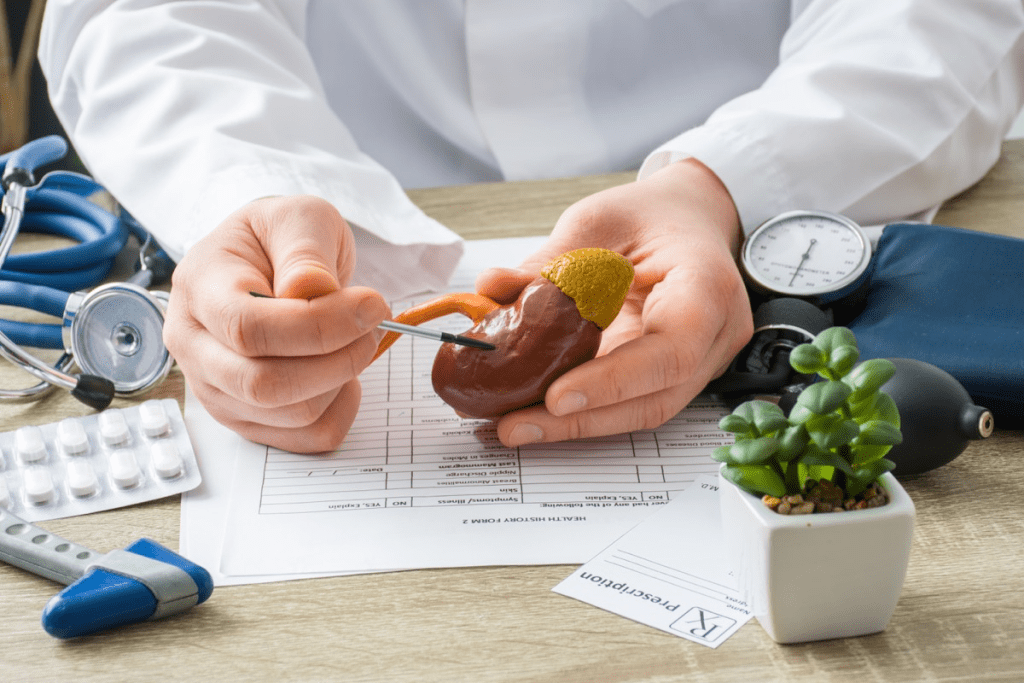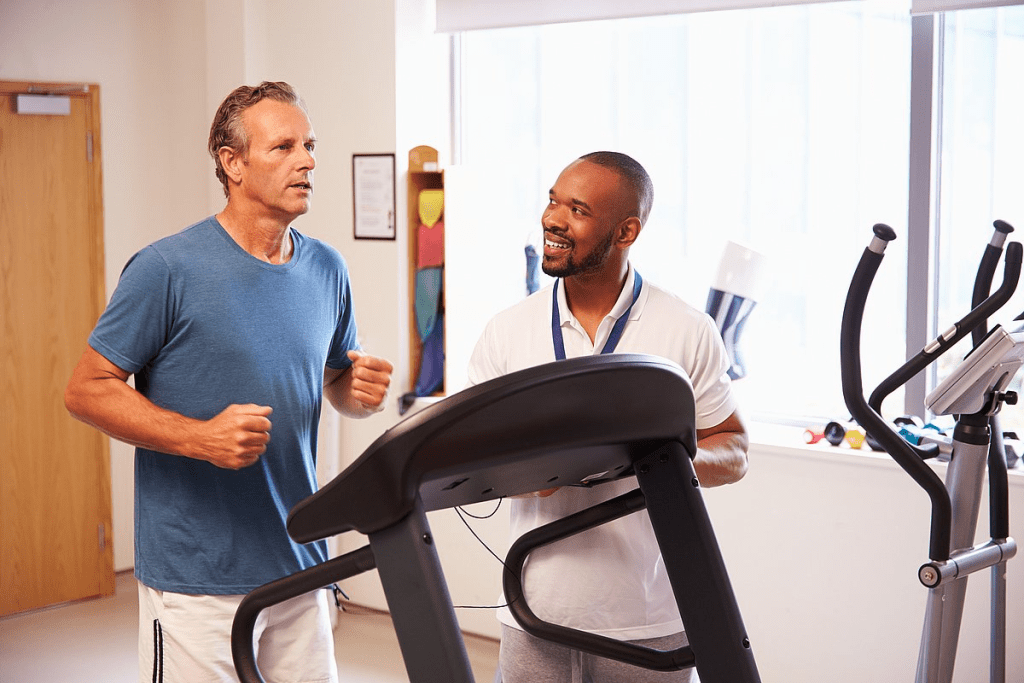Last Updated on October 31, 2025 by
Did you know exercise can help with kidney stones? Unlock our ultimate relief guide for the best movements to help pass stones faster.
We know that regular, moderate exercise is good for our health. Research shows it can also help prevent kidney stones. Activities like brisk walking, light cycling, water aerobics, and gentle stretching for 30“60 minutes a day are great.

Exercise boosts kidney function and helps keep blood pressure and weight healthy. It also aids in calcium metabolism, which lowers stone risk. Always talk to a healthcare provider before starting a new exercise routine if you have kidney stone symptoms.
Kidney stones are becoming more common in America. Almost one in ten people will get them at some point. This condition is not only painful but also poses significant health risks if not properly managed.

Every year, over 300,000 Americans go to the emergency room for kidney stones. This shows how serious this health issue is. The number of people getting kidney stones is going up, and women are more affected than ever before. Diet, lifestyle, and demographic factors are all playing a role in this trend.
Key statistics include:
Several factors are contributing to the rise in kidney stone cases. Changes in diet and lifestyle are significant contributors. Diets high in sodium, animal protein, and sugar can increase the risk of developing kidney stones. Dehydration, obesity, and certain medical conditions also play a role.
Understanding these factors is key to prevention. By making informed lifestyle choices, individuals can reduce their risk of developing kidney stones.
Exercise helps prevent kidney stones by improving kidney function and overall health. Regular physical activity offers several benefits that lower the risk of stone formation.
Exercise boosts blood flow and helps remove waste efficiently. This reduces the concentration of substances that can form stones in urine. Regular physical activity keeps kidneys working well, which is key to avoiding stones.
High blood pressure increases the risk of kidney stones. Exercise helps control blood pressure, easing the strain on the kidneys. Regular physical activity improves blood pressure, supporting kidney health.
Exercise affects calcium metabolism, linked to calcium stones, the most common type. Regular activity improves calcium metabolism, potentially lowering stone risk.
The benefits of exercise in preventing kidney stones include:

Adding regular exercise to our lives is a proactive step against kidney stones. It’s vital to pair exercise with a balanced diet and enough water for the best kidney health.
Moderate physical activities can help prevent kidney stones. They improve health and lower the risk of kidney stones.
Brisk walking and hiking are great for daily life. They boost heart health and kidney function by improving blood flow. Regular brisk walking can reduce the risk of kidney stone formation by improving kidney filtration and function.
A study found that regular physical activity, like brisk walking, can lower kidney stone risk.
“Regular physical activity…can significantly reduce the risk of kidney stones.” according to findings published in urological research.
Light cycling is good for preventing kidney stones. It’s easy on the joints and can be done by anyone. Light cycling routines can be adapted to different fitness levels, making it an accessible option for many.
Water-based exercises, like water aerobics or swimming, are great for those at risk of kidney stones. They are low-impact and relaxing, improving circulation and kidney function. Water-based exercises can help improve overall circulation and kidney function.
Health experts suggest adding water-based exercises to your routine. “Water aerobics and swimming are excellent options for those looking to prevent kidney stones through exercise.”
When trying to avoid kidney stones, it’s key to know if doing more or harder workouts is better. Studies show that doing regular workouts is more important than how hard you work out.
Staying active regularly keeps your kidneys working well and your body healthy. Regular physical activity boosts how well your kidneys filter blood and helps control blood pressure. Both are key to stopping kidney stones from forming.
It’s not about doing super hard workouts to avoid kidney stones. Instead, moderate and consistent exercise is better and easier to keep up with over time.
“The most effective exercise programs for kidney stone prevention are those that are performed consistently over time, not just intense but infrequent.”
– Expert in Urology
Research says exercising for 30-60 minutes daily is best for preventing kidney stones. This amount of time gives you good health benefits without too much strain.
These activities are not only good but also gentle on your body. They’re great for many people.
It’s important to track how well your workouts are helping prevent kidney stones. You can do this by:
By using these methods, you can see how your workouts are helping your kidney health.
Gardening and doing household chores can help prevent kidney stones. We often don’t think about how these daily tasks are good for us. They can really help us stay active.
Gardening is more than a hobby; it’s a workout that helps prevent kidney stones. Digging, lifting, and carrying heavy loads are hard work. Gardening can burn up to 300 calories per hour, depending on how hard you work.
Household chores are also a form of exercise. Vacuuming, mopping, and carrying groceries are hard work. These tasks not only keep your home clean but also help your health.
Gentle stretching is easy to do all day, even at your desk or while watching TV. It makes you more flexible and less tense. It’s something anyone can do, no matter their age or fitness level.
By adding these everyday activities to your routine, you can help prevent kidney stones. It’s about using the activities you already do and staying active all day.
For those with active kidney stones, it’s key to know how to exercise safely. The right approach depends on the stone’s size and how severe your symptoms are.
Physical activity is vital for health, but with kidney stones, caution is needed. Decide to exercise based on your symptoms and stone size.
Studies show that light activity can help with small stones and mild pain. Walking is a good example. But, always watch how your body reacts and adjust as needed.
It’s important to avoid hard activities that might make things worse. A study found that moderate exercise can lower the risk of getting kidney stones.
When exercising with kidney stones, know when to stop. Severe pain, nausea, vomiting, or trouble urinating mean you should stop and see a doctor.
If you have these symptoms, stop exercising and get medical help.
Always talk to your doctor before starting or continuing to exercise with kidney stones. They can give advice tailored to your situation and health history.
“It’s always best to consult a urologist before exercising with active symptoms to avoid any complications.”
Your doctor might suggest changes to your workout plan or recommend safer activities for you.
Being informed and careful helps people with active kidney stones exercise safely.
To make your exercise plan better for preventing kidney stones, try these extra steps. Regular exercise is key, but other lifestyle changes can also help a lot. They can improve your kidney health and lower the chance of stones.
Drinking enough water is vital, even more so when you’re active. Water helps dilute your urine, which lowers the risk of minerals forming stones. Aim to drink 8-10 glasses of water daily, more if you’re doing hard or long workouts.
Check your urine color to see if you’re drinking enough. If it’s pale yellow or clear, you’re good. But if it’s dark yellow or amber, you need to drink more.
Changing what you eat can also help prevent kidney stones. Lowering sodium intake is important because too much sodium can raise calcium in your urine. Also, eating less oxalate-rich foods like spinach and beets can help.
Eating foods high in calcium, like dairy, can bind to oxalate in your gut. This reduces oxalate in your urine. But, talk to a doctor or dietitian to find the right diet for you.
Keeping a healthy weight is also key to avoiding kidney stones. Being overweight can raise your risk, possibly because of insulin resistance and metabolic changes. Exercise and a balanced diet can help you stay at a healthy weight.
Studies show that losing even a little weight can lower your risk a lot. So, adding a weight management plan to your prevention strategy is a smart move.
Creating a lasting exercise plan is vital for keeping your kidneys healthy, which helps prevent kidney stones. Studies show that activities like brisk walking, light cycling, and water exercises are great for preventing kidney stones. Adding these exercises to your daily routine can boost your kidney function and lower the chance of getting kidney stones.
Having a good exercise schedule, staying hydrated, and eating right are all important for your kidneys. It’s important to be consistent, aiming for 30-60 minutes of moderate exercise each day. We suggest finding exercises that fit your life and enjoy, making it easier to stick to a routine that’s good for your health and reduces kidney stone risk.
Kidney stones are hard deposits made of minerals and salts. They form inside the kidneys when there’s an imbalance in urine substances like calcium and oxalate.
Exercise boosts kidney function and helps manage blood pressure. It also improves calcium metabolism. Regular activity reduces the risk of stone formation by keeping you healthy.
Brisk walking, light cycling, and water-based exercises are good. Everyday activities like gardening and gentle stretching also help your kidneys.
Aim for 30-60 minutes of exercise daily. Tracking your progress helps ensure you meet your goals.
Talk to your doctor before exercising with active stones. Exercise is okay with small stones, but stop if you have severe pain or trouble urinating.
Drink plenty of water and eat a balanced diet. Managing your weight is also key. Hydrate before, during, and after exercise.
Yes, untreated kidney stones can be dangerous. They cause severe pain and can lead to kidney damage or infection.
Monitor your progress and adjust your routine as needed. Regular check-ups and urine tests help track your success.
Diet, lifestyle, and family history play a role. Women with a family history or certain conditions are at higher risk.
Look out for severe pain, nausea, vomiting, and trouble urinating. If you have these symptoms, see your doctor.
Treatment depends on the stone’s size and your symptoms. Options include pain management, hydration, and medical procedures to remove the stone.
Subscribe to our e-newsletter to stay informed about the latest innovations in the world of health and exclusive offers!